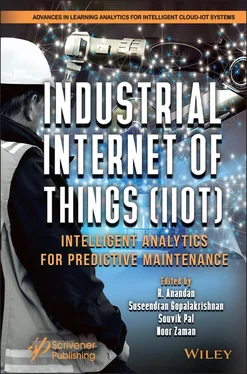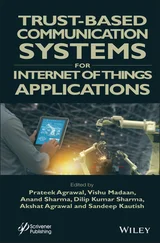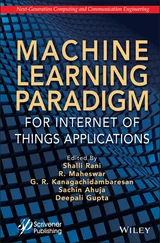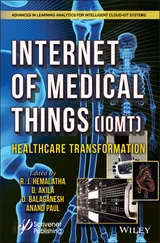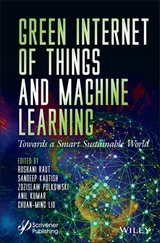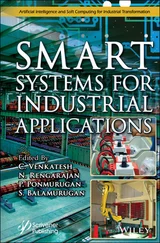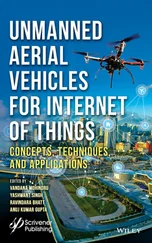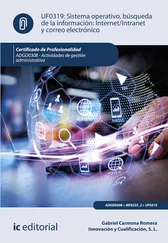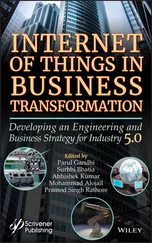Industrial Internet of Things (IIoT)
Здесь есть возможность читать онлайн «Industrial Internet of Things (IIoT)» — ознакомительный отрывок электронной книги совершенно бесплатно, а после прочтения отрывка купить полную версию. В некоторых случаях можно слушать аудио, скачать через торрент в формате fb2 и присутствует краткое содержание. Жанр: unrecognised, на английском языке. Описание произведения, (предисловие) а так же отзывы посетителей доступны на портале библиотеки ЛибКат.
- Название:Industrial Internet of Things (IIoT)
- Автор:
- Жанр:
- Год:неизвестен
- ISBN:нет данных
- Рейтинг книги:5 / 5. Голосов: 1
-
Избранное:Добавить в избранное
- Отзывы:
-
Ваша оценка:
- 100
- 1
- 2
- 3
- 4
- 5
Industrial Internet of Things (IIoT): краткое содержание, описание и аннотация
Предлагаем к чтению аннотацию, описание, краткое содержание или предисловие (зависит от того, что написал сам автор книги «Industrial Internet of Things (IIoT)»). Если вы не нашли необходимую информацию о книге — напишите в комментариях, мы постараемся отыскать её.
This book discusses how the industrial internet will be augmented through increased network agility, integrated artificial intelligence (AI) and the capacity to deploy, automate, orchestrate, and secure diverse user cases at hyperscale.
Audience
Industrial Internet of Things (IIoT) — читать онлайн ознакомительный отрывок
Ниже представлен текст книги, разбитый по страницам. Система сохранения места последней прочитанной страницы, позволяет с удобством читать онлайн бесплатно книгу «Industrial Internet of Things (IIoT)», без необходимости каждый раз заново искать на чём Вы остановились. Поставьте закладку, и сможете в любой момент перейти на страницу, на которой закончили чтение.
Интервал:
Закладка:
Big data is the term employed to refer to the enormous amount of data that is produced and stored daily, evaluating that from this abundance of information, there are intelligent systems created to organize, analyze, and interpret (that is, process) the data, which are generated by multiple sources [19, 20], still pondering on predictive analysis as the ability to identify the probability of future results based on data, statistical algorithms, and machine learning techniques. From Big Data, it is possible to do this type of analysis, identifying trends, predicting behaviors, and helping to better understand current and future needs and, finally, to qualify decision-making in machines, equipment, and software, taking technology to a new level. AI is impacting society with machine learning systems, neural networks, voice recognition, predictive analysis, and natural language processing (NLP) and continuously remodeling new aspects of human life [19, 20].
Forecasting and adaptation are possible through algorithms that discover programmed data patterns, the solutions learn and apply their knowledge for future predictions. If a sequence of bits exists, then the AI recognizes the sequence and predicts its continuity. This is also able to correct spelling errors or predict what a user will type or even estimate time and traffic on certain routes in transit (autonomous vehicles based on AI) [17].
Decision-making through data analysis, learning, and obtaining new insights is able to predict or conjecture a more detailed and faster decision than a human being. But it helps to increase human intelligence and people’s productivity. Through continuous learning, AI can be considered a machine capable of learning from standards [21].
Also related to its characteristics in the ability to build analytical models from algorithms, learning to perform tasks through countless rounds of trial and error. In the same sense, NLP provides machines and computing devices the capability to “read” and even “understand” human language [22].
1.2.1 AI Concept
Another characteristic of the basic types of AI is purely reactive, since it acts after the perception of the problem, exemplifying an AI software that identifies the chess pieces on the board and their movement, but has no memory of past movements, ignoring everything before the current movement, that is, it only reacts to the position of the pieces on the board. In the legal field, lawyers focus on more complex aspects of law practice, given the use of text analysis, Jurimetrics, text review, data mining, contract analysis, computational argumentation, and other possible AI-derived features [17, 23], still pondering the characteristics of AI-related to its capacity for intelligent perception, such as visual perception, speech perception, auditory perception, and processing and learning of perceptual information. Reflecting on autonomous cars and virtual assistants, there is not only a programmed answer to specific questions but answers that are more personalized [23–25].
Through AI solutions, it is possible to eliminate boring tasks that may be necessary, but with machine learning, it performs basic tasks, considered human-computer interaction technologies, or even related to the more robust use found in conversational interfaces that use machine learning to understand and meet customer needs [23–25].
Even through AI solutions, it is possible to concentrate diffuse problems where data inform all levels of the operation of a modern company, i.e., it has a lot of material to interpret, so it is necessary to consume this amount of information at scale. Since the extent of the data available today has gone beyond what humans are capable of synthesizing, making it a perfect job for machine learning. Through the data, the information is extracted from various sources of public and private data, still comparing them and making changes when necessary [25].
Through AI solutions, it is possible to distribute data, given that modern cybersecurity leads to the need to compare terabytes of internal data with a quantity of external data. With machine learning, it can automate the process of detecting attacks as cybersecurity problems change and increase, vital for dealing with distributed data problems, assessing that humans are unable to involve their actions around a distribution so wide of information. AI solves dynamic data, which is a valued characteristic, given the major obstacle related to addressing individual employee characteristics, or dynamic problems of human behavior. Through AI, it is possible to use determining complex patterns to help organizations move more quickly and respond better to the changing needs of each employee [26].
Or even, through AI, industrial systems integrate robotics powered by AI, 3D printing technologies, and human supervision, building interactive robot systems leading by AI technologies. This process not only decreases costs and increases efficiency but also generates much safer industrial environments for human workers. The dangerous elements of industrial activities are surpassed by machines [27, 28].
In simpler terms, AI technologies consist of intelligent systems or intelligent machines that mimic human intelligence to operate tasks and can improve iteratively supported on the information it collects. AI technologies manifest itself in various ways in modern contemporary society as chatbots to understand customer issues more quickly and provide more efficient responses or smart assistants to analyze critical data and information from large sets of free-text data to improve programming, or even at home, through recommendation mechanisms providing intuitive recommendations for TV programs supported on users’ viewing habits. However, AI technologies are not deliberate to replace human beings but aims to substantially improve human skills and actions, tasks, and even contributions [17, 23, 24].
AI is related to application areas that involve expert systems or systems based on knowledge, natural language comprehension/translation, intelligent systems/learning, speech comprehension/generation, automatic programming, or even image and scene analysis in real time, among many others. Therefore, it can be evaluated that the technological AI field aims to emulate human beings’ capabilities including problem-solving, understanding natural language, computer vision, and robotics, considering systems for knowledge acquisition, and even knowledge representation methodologies [15].
To obtain the full value of AI, Data Science is necessary ( Figure 1.3), consisting of a multidisciplinary field that employs scientific methods to collect and extract value from data, combining skills such as statistics, probabilities, frequency of occurrence of events, observational studies, and computer science, with business knowledge to analyze data gathered from distinct sources [29, 30].
The central principle of AI technologies is to replicate, and then exceed, the processes and conduct humans perceive, notice, see, and react to the world, fueled by several forms of Machine Learning techniques that recognize patterns in data to allow prognosis and predictions. Propitiate a better comprehensive understanding of the wealth of available data, information, and predictions to automate overly complex or ordinary tasks, improving productivity and performance, automating tasks or processes that previously demand human energy, and also making sense of the data on a superhuman scale [31].
Data science makes it a priority to add technological value to business intelligence and advanced analysis as the main technology differential for companies, through the use of demographic and transactional data to foresee and predict how much certain customers and users will spend over their business relationship with a company (or even the customer’s lifetime value), price optimization supported on preferences and customer behavior, or even utilizing image recognition techniques to analyze X-ray digital images searching for signs of cancer [30].
Читать дальшеИнтервал:
Закладка:
Похожие книги на «Industrial Internet of Things (IIoT)»
Представляем Вашему вниманию похожие книги на «Industrial Internet of Things (IIoT)» списком для выбора. Мы отобрали схожую по названию и смыслу литературу в надежде предоставить читателям больше вариантов отыскать новые, интересные, ещё непрочитанные произведения.
Обсуждение, отзывы о книге «Industrial Internet of Things (IIoT)» и просто собственные мнения читателей. Оставьте ваши комментарии, напишите, что Вы думаете о произведении, его смысле или главных героях. Укажите что конкретно понравилось, а что нет, и почему Вы так считаете.
